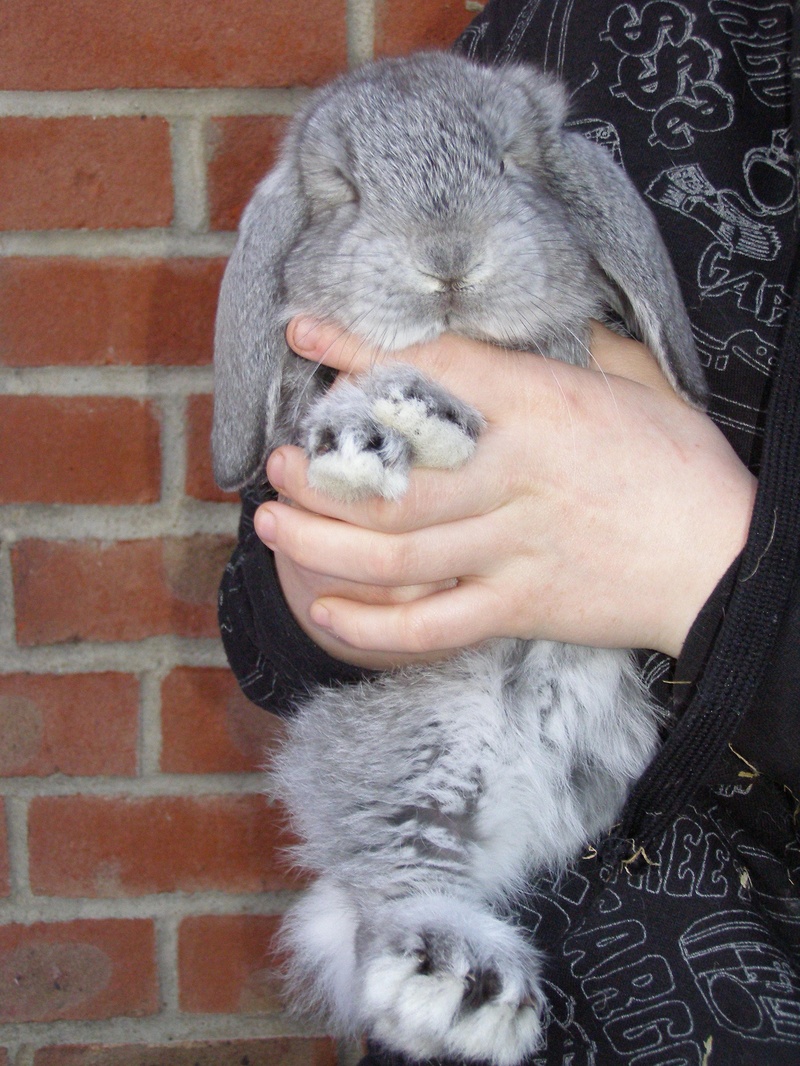Management of Rabbit
Good management practices include handling, feeding, breeding, disease control, sanitation etc. Most of them have been dealt in different chapters. Handling and sanitation are discussed.
1. Handling of Rabbit
Rabbit is a restless animal. It should be handled gently and carefully so that it is not frightened. Rabbit is generally lifted by grasping the loose skin of the neck region by one hand and placing the other hand below the hindquarter to support the weight. Rabbit should not be lifted by holding the ears. The ears may be grasped along with loose skin of the shoulder region if required. Careless handling or improper security may lead to fracture and injury since it will continue to struggle for escape. Even during struggling it may scratch the handler with claws. Young rabbit may be picked up and carried in one hand by gently grasping the loin.

Rabbit Handling
2. Sanitation
Strict sanitation practices are of paramount importance in rabbit farming. Improper or inadequate sanitation may lead to various infections through spreading of infective germs. Buildings should be well ventilated and sufficiently lighted. Over crowding should be avoided since many diseases spread through contact.Disinfection may not provide cent percent security. But, it must be done to minimize spread of infection. Regular and frequent, preferably daily removal of waste including manure, unused feed, soiled bedding and nesting material is absolutely essential in either solid or wire floored cages. This is to be done to avoid breeding of flies and thus infection through them. Wastes should be removed from the premises each day. All equipments including water bottles, feed trays and nest boxes should be periodically washed with soapy (hot) water and rinsed with chlorine or other suitable disinfectant solution or steam. Rabbit hairs may pose a problem. Pregnant does may pluck hairs from their bodies to make nest. These hairs may stick to anywhere of the cages.
These hairs are required to be removed. This is best done manually or to burn through flames. Regular brushing may help to reduce hairs. In large farm vacuum cleaner will be the most suitable appliance for this purpose. Metal surfaces of the cages may be sterilized with blow lamp. Floor and the walls may be disinfected with 1 to 2% formalin or I% sodium hydroxide or 10% ammonia solution. Recently marketed disinfectants used for poultry houses may be used as per the direction. Cages of bucks should be disinfected at an interval of 3 days during mating period. The nest box should be adequately disinfected before it is used for the purpose. During kindling period, all the faecal materials should be disposed immediately otherwise the litters may lick them and pick up diseases like coccidiosis which is a faecal borne disease. In a nutshell, all the materials used for feeding, watering, rearing, breeding and weaning as well as maintaining of rabbits should be kept clean, free from contamination and infecting agents through strict hygienic and sanitary measures.
Manure should be removed at periodical interval to lower down ammonia level in the farm. Ammonia gas has got detrimental effect on the health of rabbits especially it causes breathing problem.
3. Identification
Some breeders may prefer to make arrangement to identify the breed. Identifications may be made permanently through the use of rings, tattooing in the ear, ear notching, ear clip or colour coded ear button. Leg ring can also be used for this purpose.
4. Transport of Rabbit
Transportation has significant implications in small breeds like rabbits. Rabbits are very delicate and hence they are susceptible to changes in climate and long journey. They are in general unable to cope with the stress and strain of long continuous journey. Immature rabbits can be transported in crates or like adults in specially constructed traveling boxes which should be light proof and water proof .Resin bound plywood is suitable for this purpose.
Measurement should be as follows:
Height 30-35cm, Width 20-30cm, Length 35-45cm there should be proper ventilation through lids and sides with baffle boards to prevent draughts. The animal should be taken and the cages should be so backed as to prevent jerking during journey. Proper bedding materials should be provided. Trucks used for this purpose should be cleaned before and after transportation. The rabbits should be vaccinated against diseases. Sick animal not be transported.
(Source: Namakkal KVK, Rabbit Farming Book)
| 
